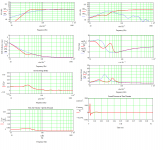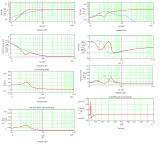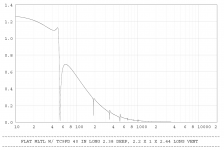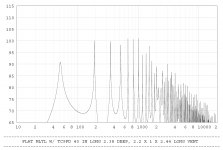One way to cheat is to use a length similar to a known MLTL for a known driver size.
It's a function of Fb and how much acoustic vent damping you want. Most folks are more interested in driver vertical height though, so this limits pipe length if the driver is located at the top; otherwise you can use MJK's driver offset recommendations to find it.
GM
Hi all,
I agree that Bob said..
I see many reasons to use MJ King software :
I build several speakers with it, results and design are very close, mesurements too.
You have response in room, with placement walls effect and so, so you can adjust lenght of port for example in MLTL..
Almost kind of speakers can be modelized with sheets, also closed box and others with a little imagination.
Finally, you have support on Yahoo group if you need help, Martin and members are very available and open-minded..
Phil.
@ Bjohannesen : great work !
I agree that Bob said..
I see many reasons to use MJ King software :
I build several speakers with it, results and design are very close, mesurements too.
You have response in room, with placement walls effect and so, so you can adjust lenght of port for example in MLTL..
Almost kind of speakers can be modelized with sheets, also closed box and others with a little imagination.
Finally, you have support on Yahoo group if you need help, Martin and members are very available and open-minded..
Phil.
@ Bjohannesen : great work !
It's a function of Fb and how much acoustic vent damping you want. Most folks are more interested in driver vertical height though, so this limits pipe length if the driver is located at the top; otherwise you can use MJK's driver offset recommendations to find it.
GM
GM,
I think you stated very clearly the limiting factors to the length of the TL: mostly practical reasons for driver height. It's kind of like designing a BLH - you start with asking yourself what is the longest length and what is the area of the mouth you can practically have and work backwards. For a MLTL, unless folded, this length ends up being from 30 to 45 for a straight rectangular one, and up to 60 in for tapered quadratic MLTL like the Met where the driver is sometimes placed about halfway down or at 30 in. There is of course a relation between driver fs and max length too that determines fb as you don't want fb to be so low below fs that it makes the driver operate in a region where it is not meant to work.
There are plenty of taller designs out there. I've done quite a few 6ft + tall MLTLs & ML conical horns / quadratic pipes / TQWT (in the modern parlance). I usually won't go beyond 8ft tall though since I live in the UK, & most homes over here have a ceiling height of 8ft, so fitting it in is tricky. I think 16ft is the biggest I've bothered with as a one-off a couple of years back -it's on an old HDD somewhere. If I know GM, he'll have done (far superior) boxes that are even larger at some point... 
Depends where / how you locate the driver of course, & what the box is for; wideband configurations are usually more critical for obvious reasons, whereas a dedicated bass enclosure gives a bit more latitude.
Edit: couldn't find the large one; will need to go through some of my other drives, but here's a 57in MLTL for the F200a I did a while back for sake of example. Note this is a flat alignment without forcing assuming the user will adjust the vent tuning to their requirements. I didn't bother optimising the damping levels.
L = 57in
CSA = 100in^2
Zd = 20.427in
Zv = 54in
Duct 4in diameter x 2in long
Line top, back & one sidewall with acoustic fiberglass & adjust from there to suit.
Depends where / how you locate the driver of course, & what the box is for; wideband configurations are usually more critical for obvious reasons, whereas a dedicated bass enclosure gives a bit more latitude.
Edit: couldn't find the large one; will need to go through some of my other drives, but here's a 57in MLTL for the F200a I did a while back for sake of example. Note this is a flat alignment without forcing assuming the user will adjust the vent tuning to their requirements. I didn't bother optimising the damping levels.
L = 57in
CSA = 100in^2
Zd = 20.427in
Zv = 54in
Duct 4in diameter x 2in long
Line top, back & one sidewall with acoustic fiberglass & adjust from there to suit.
Attachments
Last edited:
Scottmoose,
Thanks for providing this design - looks very nice. Also a very nice driver that has an fs of 30 Hz yet it looks like you are tuning this cabinet to have a fb of a little under 60 Hz. So if I were to design a MLTL for the F200A using AMLTL, here is what I get:
From WinISD, it suggests a default volume of 43 liters which seems a bit small, albeit the freq response was very flat. So to get the response down into the 30's I increased the vb and fb until the bass extension gets down to about 38 Hz with a small overshoot bump. Perhaps this is where my method is going astray vs doing a MJK sim - as the driver displacement and group delay may be going to HIAHB. Nonetheless, here is the AMLTL design:
L = 60 in
Vol = 100 liters
Baffle width = 11 inches
Depth = 9.25 inches
Zdriver = 1/3 of L = 20 inches
Vent = 4 in dia x 4 in long
Use stuffing from closed end to 40 inches down, leaving last 20 in open.
If you want and have time, maybe you can take this AMLTL design for the F200A and run a MJK simulation on it and show me how bad (or good) it is.
Thanks for providing this design - looks very nice. Also a very nice driver that has an fs of 30 Hz yet it looks like you are tuning this cabinet to have a fb of a little under 60 Hz. So if I were to design a MLTL for the F200A using AMLTL, here is what I get:
From WinISD, it suggests a default volume of 43 liters which seems a bit small, albeit the freq response was very flat. So to get the response down into the 30's I increased the vb and fb until the bass extension gets down to about 38 Hz with a small overshoot bump. Perhaps this is where my method is going astray vs doing a MJK sim - as the driver displacement and group delay may be going to HIAHB. Nonetheless, here is the AMLTL design:
L = 60 in
Vol = 100 liters
Baffle width = 11 inches
Depth = 9.25 inches
Zdriver = 1/3 of L = 20 inches
Vent = 4 in dia x 4 in long
Use stuffing from closed end to 40 inches down, leaving last 20 in open.
If you want and have time, maybe you can take this AMLTL design for the F200A and run a MJK simulation on it and show me how bad (or good) it is.
Last edited:
Actually, the box I posted above is tuned to 35Hz, as you can see from the graphs.
An alternative, marginally forced alignment (Fb 29Hz) that I did a few years back:
L = 46.5in
CSA 120in^2
Zd = 9.375in
Zv = 43.5in
Duct 3in diameter x 3in long
Damping as above. Again, this is a flat alignment with non-optimised damping, on the assumption that a builder would adjust the tuning & damping to suit their particular requirements.
Generally speaking I prefer not to use forced alignments (i.e. tuning below Fs) these days. The option is there if necessary, but I don't much like it, above all with smaller drivers which have enough problems in the LF without being asked to do something they are inherently unsuited for. Bigger units = (usually) less of an issue, but I still don't much care for pushing drivers as hard as possible. The results are seldom worth the effort.
An alternative, marginally forced alignment (Fb 29Hz) that I did a few years back:
L = 46.5in
CSA 120in^2
Zd = 9.375in
Zv = 43.5in
Duct 3in diameter x 3in long
Damping as above. Again, this is a flat alignment with non-optimised damping, on the assumption that a builder would adjust the tuning & damping to suit their particular requirements.
Generally speaking I prefer not to use forced alignments (i.e. tuning below Fs) these days. The option is there if necessary, but I don't much like it, above all with smaller drivers which have enough problems in the LF without being asked to do something they are inherently unsuited for. Bigger units = (usually) less of an issue, but I still don't much care for pushing drivers as hard as possible. The results are seldom worth the effort.
Attachments
Last edited:
Wideband driver based HT without a sub / subs & highpass on the mains is asking for trouble except in a small space & low SPLs.
Welcome to the world of the limits of wideband drivers. Dynamic range for many is miserable, although without multiple qualifications, Xmax itself doesn't tell you anything since the manufacturers rarely state what method was used to put a figure on it, and none of them are without major caveats in any event. You really need to measure the drivers & their distortion behaviour. Mind, if that's a big concern for you, you'd be well advised to abandon tuning 3in Vifa drivers to ~50Hz (sorry, couldn't resist).
(sorry, couldn't resist).
Welcome to the world of the limits of wideband drivers. Dynamic range for many is miserable, although without multiple qualifications, Xmax itself doesn't tell you anything since the manufacturers rarely state what method was used to put a figure on it, and none of them are without major caveats in any event. You really need to measure the drivers & their distortion behaviour. Mind, if that's a big concern for you, you'd be well advised to abandon tuning 3in Vifa drivers to ~50Hz
If I know GM, he'll have done (far superior) boxes that are even larger at some point...
I doubt that, there's only so much one can do with what is essentially a very high efficiency reflex alignment. WRT max length, some of mine were for drivers with as low as a 20 Hz Fs, so with what were essentially BVR-BIBs, the path-length could get quite long and with Vas running as high as 1 k+ L, net Vb necessitated they be built in sections.
Today there's drivers with specs that allow good size back loaded or even compression loaded corner horns in a smaller net Vb, so no reason to ever consider making another one.
GM
Wideband driver based HT without a sub / subs & highpass on the mains is asking for trouble except in a small space & low SPLs.
Welcome to the world of the limits of wideband drivers. Dynamic range for many is miserable, although without multiple qualifications, Xmax itself doesn't tell you anything since the manufacturers rarely state what method was used to put a figure on it, and none of them are without major caveats in any event. You really need to measure the drivers & their distortion behaviour. Mind, if that's a big concern for you, you'd be well advised to abandon tuning 3in Vifa drivers to ~50Hz(sorry, couldn't resist).
Actually, the HornResp simulations for the Vifa with the Flat MLTL shows a driver diaphragm maximum displacement of only 1.2 mm at 52 Hz (xmax is listed as 2.5 mm by manufacturer). And it levels off rather than getting higher and higher with lower freq.
Attachments
Last edited:
Not sure about the Vifa, but the TB W3-881SI has an incredibly slow low-end roll-off which I think is a big part of the reason why it performs as well as it does in an AMLTL.
Look at the response graph. As you can see, at 1w/1m the driver is still pushing 75dB at 50Hz. At 20Hz, it still manages 60dB.
I am sure I am overstating the obvious when I say that I don't know anything about cabinet design, however I do not really find it all that shocking that a particular cabinet can allow this driver to produce useful bass down to the last string on a 4-string bass (whether by accident or not). I listen to them doing it on a daily basis and no, excursion is not extreme and distortion is not evident unless someone gets stupid with the volume knob. I don't.
I tried some measurements, as promised, with HolmeImpulse the other day. I was getting very odd results from all my speakers so I gave up and made dinner instead (well-trained). I realized later that the last time I had HI working well, I had been using my web-cam mic, not the internal laptop mic.
What I did do later, however, is make another video which directly compares the nanoTowers to the Pensil 10.2s. I will be uploading that to Youtube soon. No, it is not ideal, but it is good enough to get an idea of how the speakers compare to each other, in the same room, in the same positions, with the same amplification, source material, volume, etc. In other words, if one set of speakers had laughably low bass, it would be obvious in the video. As you will see, neither of them do. I also plan to run the audio tracks (identical sequences of the same music) from each sample through Audacity's FR analysis, to better show just what frequencies each set of speaker is capable of producing. It will be easy to see that producing rich, full range sound at moderate SPL with a 3" driver is not an unreasonable thing to do.
Look at the response graph. As you can see, at 1w/1m the driver is still pushing 75dB at 50Hz. At 20Hz, it still manages 60dB.
An externally hosted image should be here but it was not working when we last tested it.
I am sure I am overstating the obvious when I say that I don't know anything about cabinet design, however I do not really find it all that shocking that a particular cabinet can allow this driver to produce useful bass down to the last string on a 4-string bass (whether by accident or not). I listen to them doing it on a daily basis and no, excursion is not extreme and distortion is not evident unless someone gets stupid with the volume knob. I don't.
I tried some measurements, as promised, with HolmeImpulse the other day. I was getting very odd results from all my speakers so I gave up and made dinner instead (well-trained). I realized later that the last time I had HI working well, I had been using my web-cam mic, not the internal laptop mic.
What I did do later, however, is make another video which directly compares the nanoTowers to the Pensil 10.2s. I will be uploading that to Youtube soon. No, it is not ideal, but it is good enough to get an idea of how the speakers compare to each other, in the same room, in the same positions, with the same amplification, source material, volume, etc. In other words, if one set of speakers had laughably low bass, it would be obvious in the video. As you will see, neither of them do. I also plan to run the audio tracks (identical sequences of the same music) from each sample through Audacity's FR analysis, to better show just what frequencies each set of speaker is capable of producing. It will be easy to see that producing rich, full range sound at moderate SPL with a 3" driver is not an unreasonable thing to do.
Last edited:
Metronome-inspired design for TC9FD
Despite admonitions by Scottmoose against making a Met-like design with the Vifa TC9FD as being unsuitable for resonant enclosures. I proceeded nonetheless.
In WinISD, I pretty much used very close to the default BR box volume and tuning it recommended which was 16.9 liters and 56.4 Hz. I played a little with the tuning to get 17.2 liters and 55 Hz with a 2 in dia vent that is 3.07 in long.
I have made a MLTL for this driver at 40 in long before so I will stick with that for the pipe length, also it is a reasonable height for the driver once I elevate the bottom with some feet to allow the bass port to exit.
So how to design the rectangular obelisk sizes? Based on purely practical reasons for easy building, I set the top to be 1 in x 3 in, I then set the dimension of one of the bottom side edge to be 6 in to give enough stability to the speaker and clearance for the driver magnet.
Using the formula for the volume of prism with unequal top and bottom faces (which we recently discussed in another thread) given by Vol = (Area_top + Area_bottom)/2 x height, I solved for the remaining edge so that the Vol = 17.2 liters.
17.2 liters = 1050 cu in = (1 x 3 + Edge x 6)/2 x 40, solve for Edge
Edge = 8.25 in.
So I now have a design that looks somewhat Met-like as an obelisk.
Base is 8.25 in wide x 6 in deep
Top is 3 in wide x 1 in deep
Length is 40 in
Vent is 2 in dia x 3.07 in long.
Driver is 13.3 in from top.
Stuffing will be in top 26 in, remaining volume to leave empty.
I wonder how this will sound? Given that it is longer than 30 in, I will have to join foam core sheets to get the extra length. This may require facing with a thin 1/4 inch plywood to make it look good.
Despite admonitions by Scottmoose against making a Met-like design with the Vifa TC9FD as being unsuitable for resonant enclosures. I proceeded nonetheless.
In WinISD, I pretty much used very close to the default BR box volume and tuning it recommended which was 16.9 liters and 56.4 Hz. I played a little with the tuning to get 17.2 liters and 55 Hz with a 2 in dia vent that is 3.07 in long.
I have made a MLTL for this driver at 40 in long before so I will stick with that for the pipe length, also it is a reasonable height for the driver once I elevate the bottom with some feet to allow the bass port to exit.
So how to design the rectangular obelisk sizes? Based on purely practical reasons for easy building, I set the top to be 1 in x 3 in, I then set the dimension of one of the bottom side edge to be 6 in to give enough stability to the speaker and clearance for the driver magnet.
Using the formula for the volume of prism with unequal top and bottom faces (which we recently discussed in another thread) given by Vol = (Area_top + Area_bottom)/2 x height, I solved for the remaining edge so that the Vol = 17.2 liters.
17.2 liters = 1050 cu in = (1 x 3 + Edge x 6)/2 x 40, solve for Edge
Edge = 8.25 in.
So I now have a design that looks somewhat Met-like as an obelisk.
Base is 8.25 in wide x 6 in deep
Top is 3 in wide x 1 in deep
Length is 40 in
Vent is 2 in dia x 3.07 in long.
Driver is 13.3 in from top.
Stuffing will be in top 26 in, remaining volume to leave empty.
I wonder how this will sound? Given that it is longer than 30 in, I will have to join foam core sheets to get the extra length. This may require facing with a thin 1/4 inch plywood to make it look good.
As you will see, neither of them do. I also plan to run the audio tracks (identical sequences of the same music) from each sample through Audacity's FR analysis, to better show just what frequencies each set of speaker is capable of producing.
I have done the same thing before with Audacity. It has a nice FFT analysis feature that lets you check to see if you really are getting that 41 Hz note. If you get a pink noise generator mp3 you can also do a spectral analysis of the speaker without doing a sweep. This is really interesting to do on a BLH, especially one like the Cornu with different length outputs. You put pink noise in and listen to each horn and the sound coming out is just bass notes. With the different length horns you can hear that one is higher bass and other is lower bass.
Actually, the HornResp simulations for the Vifa with the Flat MLTL shows a driver diaphragm maximum displacement of only 1.2 mm at 52 Hz (xmax is listed as 2.5 mm by manufacturer). And it levels off rather than getting higher and higher with lower freq.
...and now think of the sound pressure levels obtained, and how much dynamic range you'll have available.
Last edited:
I agree that the bass is limited in SPL but given that the Vifa is a 85 dB efficiency driver and HornResp predicts 90+ dB for the bass, not too bad and rather balanced from what I hear. Definitely sounds way better than any portable radio I have heard - some of it might be fact that it is wall mounted so bass is enhanced.
That is the peak that HR shows at 52 Hz. I did not use HR to tune but rather to see what the result of the AMLTL looks like. Of course there is no stuffing which once you account for it, it will smear and lower everything in amplitude. But the sound is definitely not missing the bass.
- Home
- Loudspeakers
- Full Range
- Accidental MLTL Technique



